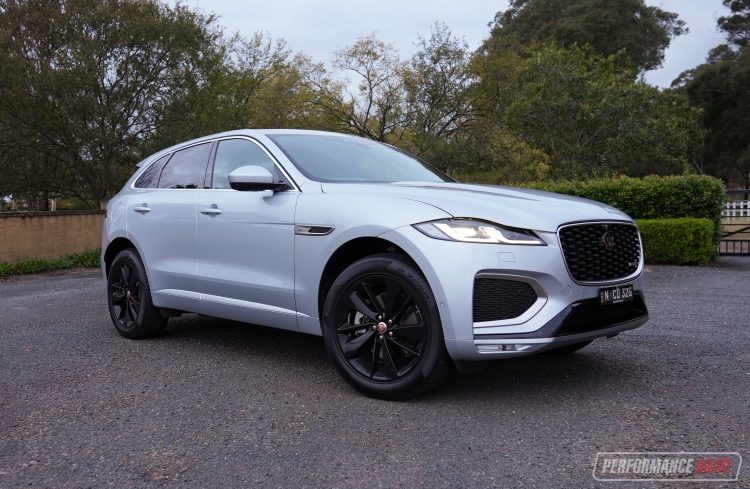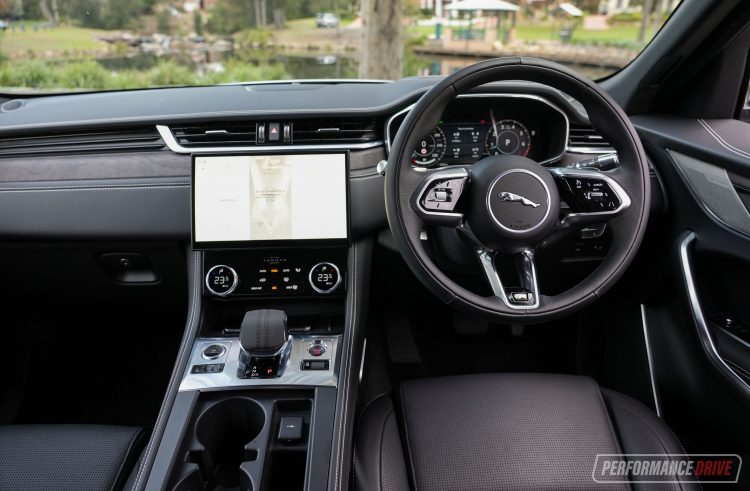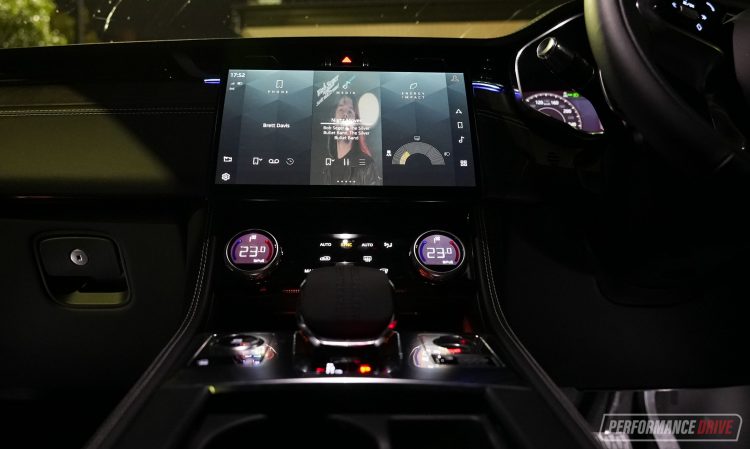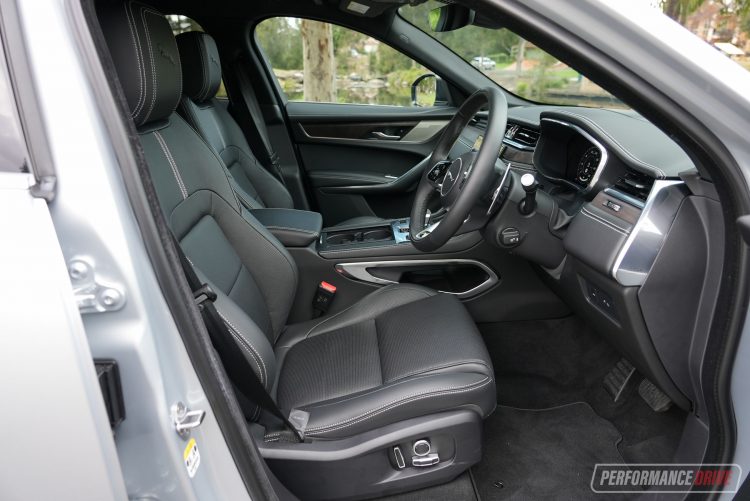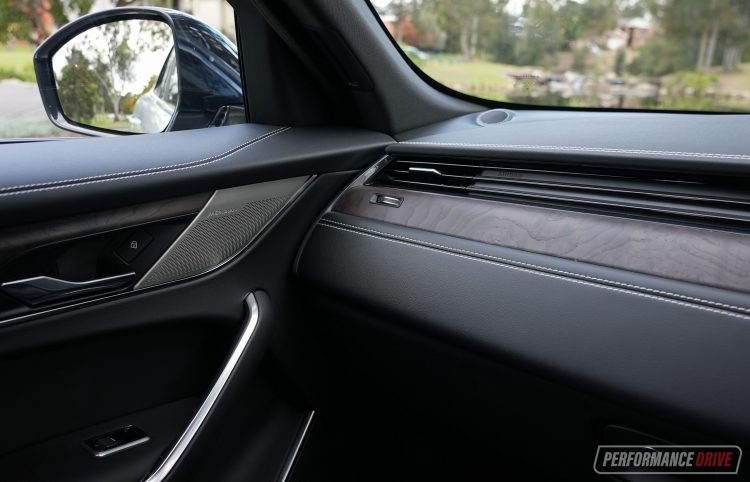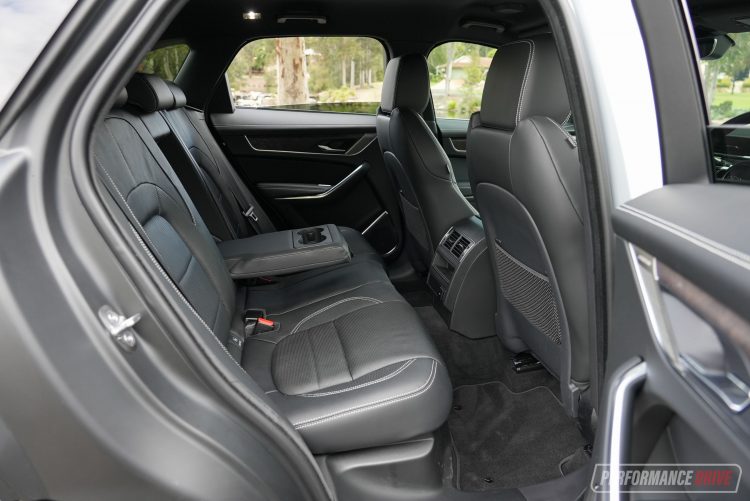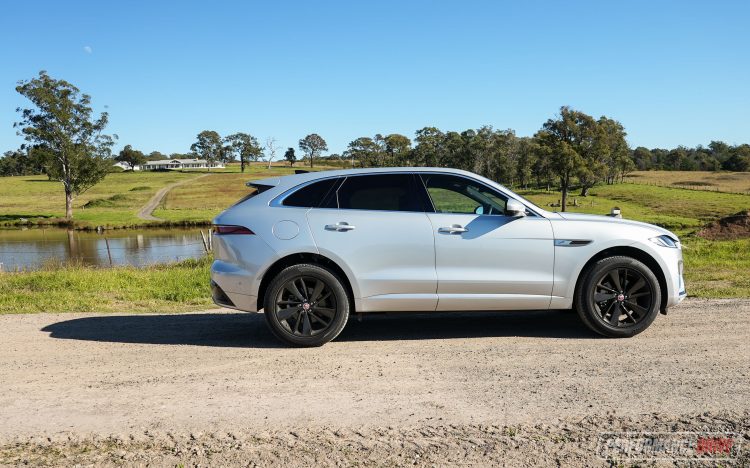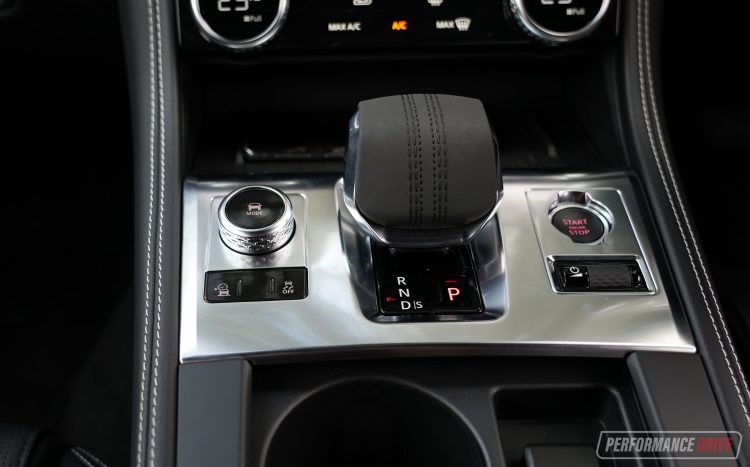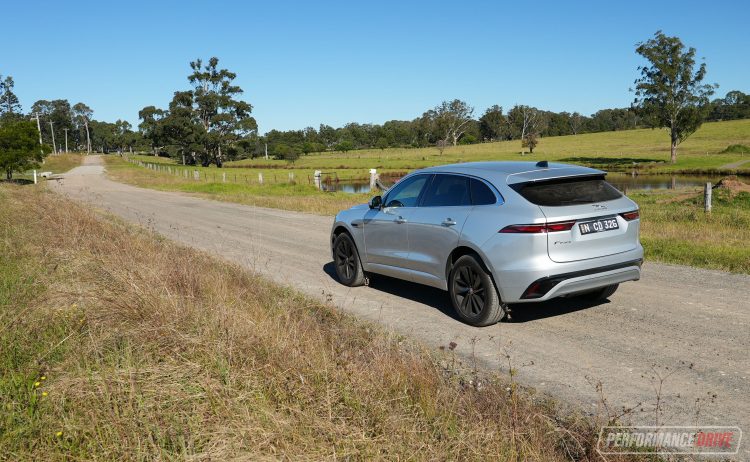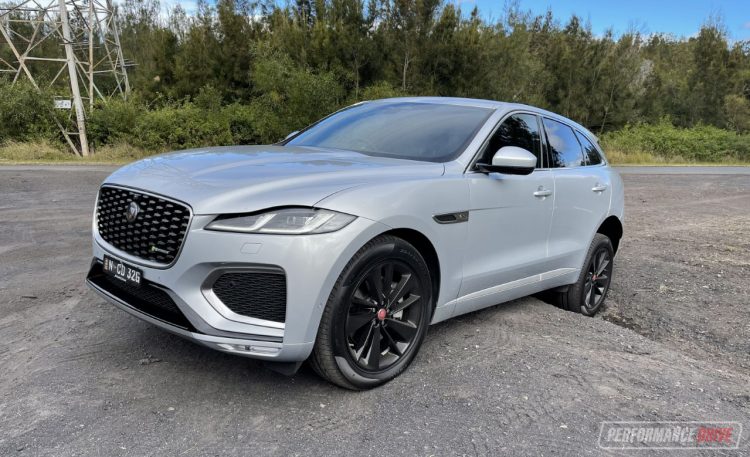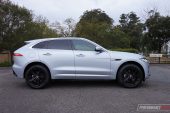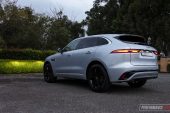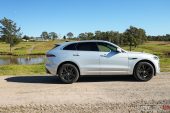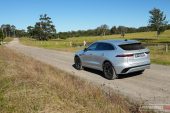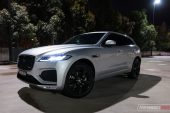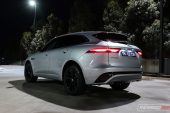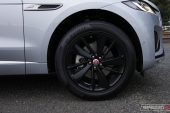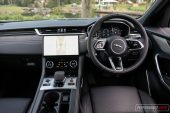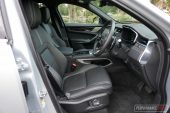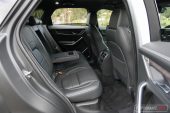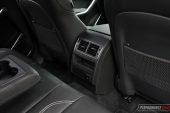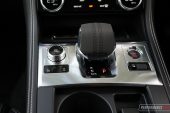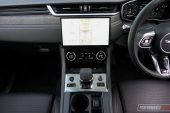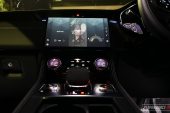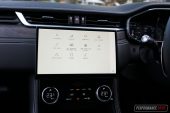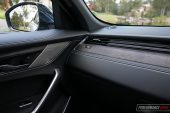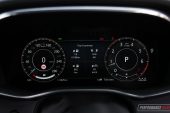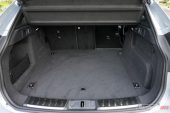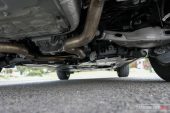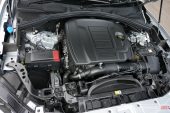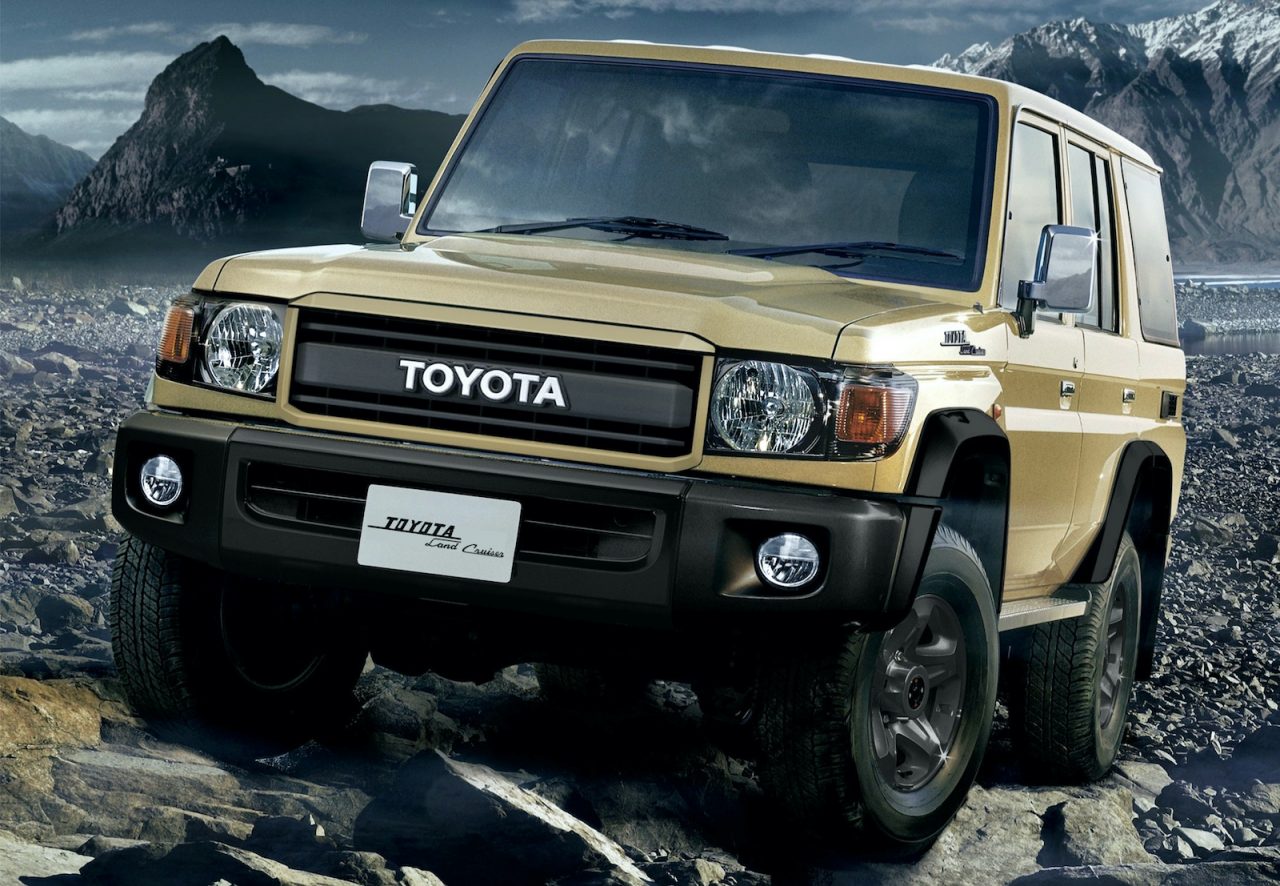The 2021 Jaguar F-PACE has had somewhat of a birthday, receiving styling tweaks both external and internal, a major technology overhaul, and new engine options. Today we’re looking at the entry-level model called the P250 S.
The F-PACE competes in the premium medium SUV segment that is literally flooded with offerings. Fierce competitors include the Audi Q5, BMW X3, Mercedes GLC, and even the F-PACE’s sibling, Range Rover Velar. Some of these start from around the $70k mark. The thing is, they invariably feature an engine with only mild power output.
This entry F-PACE P250, starting from a slightly higher $76,120, features a 2.0-litre turbo-petrol four-cylinder that puts out 184kW and 365Nm. That makes it the most powerful entry model when compared against those German rivals (150kW, 135kW, and 145kW, respective to above). In that regard, you get the sense the underlying character here is sportiness.
2021 Jaguar F-PACE P250 S R-Dynamic – THE SPECS
[column width=”47%” padding=”6%”]Engine: 2.0-litre turbo-petrol four-cylinder
Output: 184kW@5500rpm / 365Nm@1300-4500rpm
Transmission: Eight-speed auto
Drive type: All-wheel drive
Wheels: F & R: 19×8.5, 255/55 (20s fitted)
ANCAP: Five stars
Tare weight: 1768kg
Power-to-weight: 9.60:1 (kg:kW)
Official fuel economy: 7.8L/100km
Economy during test: 10.1L/100km
Fuel capacity/Type: 82L/95 RON[/column] [column width=”47%” padding=”0″]Power efficiency: 23.58kW:L/100km
0-60km/h: 3.64 seconds*
0-100km/h: 7.90 seconds*
60-110km/h: 5.50 seconds*
1/4 mile: 15.75 seconds at 146.8km/h*
Max acceleration: 0.940g
100-0km/h braking: 3.02 seconds at 38.67 metres*
Max deceleration: -1.255g
Decibel at idle: 43*
Peak decibel at 60-100km/h: 79*
Priced from: $76,120[/column][end_columns]
* Figures as tested by PerformanceDrive on the day. Factory claims may be different
2021 Jaguar F-PACE P250 S R-Dynamic – THE PACKAGE
First, we must talk about the controls and buttons inside. Most of the in-car functions are found within the spectacular new 11.4-inch curved touch-screen, running JLR’s latest Pivo Pro operating system. This is a brilliantly presented interface, with very nice graphics and a mostly-intuitive menu layout. We think it is a bit bright at night though, even in the designated ‘dark’ mode and with the main brightness control switch to the right of the steering wheel (great that this physical switch remains) turned right down.
There’s a dedicated page for special apps on the screen, including configurations for the dynamic driving mode and off-road ‘all-surface information’ readouts, and a main setting page which, rather annoyingly, contains the off switch for the stop-start engine system (a hunt, for anyone who likes to regularly turn this function off). But overall it is a really nice screen and offers plenty of possibilities while reducing clutter around the dash. A seperate panel houses the climate controls.
On the steering wheel though, things are a bit more complicated. Around the button that allows you to change songs is also the call button. But this changes, like a mini digital screen, depending on what you’re doing. Clever, yes. But it does take some time to get used to. The menu for the instrument cluster is also controlled via a single spindle wheel on the steering wheel. Try navigating around all of this while you’re driving. It’s not ideal.
Another minor annoyance is the climate control. The temperature and fan functions are done with a push-pull action, switching between the two. Again, while you’re driving it can seem near impossible to conduct this operation without becoming distracted. It looks fancy but is awkward in action.
The driving modes on offer suffer from what feels like a long delay when swapping between modes; Dynamic, Comfort, Eco, and Ice/Snow. It just seems to take forever. It’s not like the car has to change from 2WD to AWD, or even low-range. We’d understand that. But choosing these modes, it seems like something way more serious is going on under the surface.
Though this is only a mid-size SUV, the interior feels very spacious for both leg and headroom. It’s cosy but spacious. The front seats are great on long trips and certainly provide a snug hold in the bends. Adding to this intimacy, the steering wheel feels great to hold. It’s not too thick, nicely sized, and falls right into your hands. The paddle shifters are also well-spaced and feel good.
The rear seat isn’t really a place for three adults, but it can be done – this reviewer is 194cm tall and headroom wasn’t an issue in any of the seats. In the middle though there is a large driveline hump which does soak up space. So, you tend to have raised knees and this can cause them to rub against the front seats. Compared with the market rivals it is no big deal. We just know there are some models that offer a bit more freedom here.
By far the biggest standout for the new F-PACE is the design and (most) materials. Aluminium trimmings are standard, but you can option for real satin charcoal or natural burr wood veneers to run across the dash (for just $416), like on this test vehicle. These really spruce up the quality feel and appearance of the cabin.
The metallic trim and standard grained leather all combine to provide a very British vibe. Which is good to see given Jaguar is an iconic British marque, despite being owned by Tata Motors. This doesn’t suffer an identity issue, that’s for sure.
2021 Jaguar F-PACE P250 S R-Dynamic – THE DRIVE
While the P250 model is the lowest-powered of the new F-PACE range in Australia, the engine is quite happy around town but also swift out on the open road. It would feel right at home doing a trip to the snow, for instance. You know, the kind of enduring open road stuff that requires a long-leg stride. This is helped by the low and wide spread of torque, with the peak available from 1300rpm to 4500rpm.
That said, if you really ring its neck the motor offers a lot in up-front punch but then it flattens off. In that sense the torque is strong but the peak figure of 365Nm isn’t all that high. Especially for a 1768kg vehicle. Obviously if you’re after more go there’s always the 221kW D300 diesel, 294kW P400 inline-six petrol, or the fire-breathing 405kW supercharged V8 SVR.
Jaguar does offer a range of driving modes, as mentioned, and these can improve the overall versatility. There’s also a normal D and exciting S mode for the transmission. The best of all worlds we found was Dynamic mode while leaving the transmission in D. It’s responsive when you need it to be, and relaxed when you don’t.
The eight-speed automatic can be a little indecisive and laggy in slower-speed situations. It’ll kick down and rev more than you’d like sometimes when all you wanted was a little burst of acceleration, while other times it behaves more predictably. In S mode this obviously changes, ensuring the lower gears are always at the ready or already engaged.
Switching over to Eco mode does reduce throttle sensitivity, but it no doubt helps to increase fuel efficiency. On paper the P250 consumes 7.8L/100km across the official combined cycle. During our week with this vehicle the trip computer showed an average of 10.1L/100km. We think that is a bit high, and certainly high against some of those lower-powered entry-spec rivals mentioned at the start.
In this we felt the need to lean on the pedal more so than in the inline-six F-PACE options (reviews coming soon) – for example, we have since averaged around 11.5L/100km in the 294kW P400 model (official rating is 8.7L/100km). But in the lesser-power rivals we’d probably lean on the pedal even more. So you should take our experience as a guide only.
Handling is fantastic. The F-PACE has a real hunker-down, grip and go feel about it. It hugs corners much better than a mid-size SUV should. With the four-cylinder engine the front end does feel light and pointy, too. And there’s loads of feel-good feedback through the steering. The optional 20-inch wheels (as fitted here) do throw off some road noise, but don’t they just look great? Jaguar always seems to do very well in wheel design.
In normal conditions the quite large side mirrors provide lots of rearward vision, though, like many cars in this segment, the small rear window means vision of what’s directly behind you is limited. The A-pillar also leans down and can impede diagonal vision, depending on your preferred seating position.
This is an SUV and it does promise some level of off-road performance. There’s a low-grip launch mode, which is perfect for towing boats on slippery ramps, and an Ice/Snow mode. We didn’t take on any crazy 4×4 tracks during our test, but we did do some light off-roading just to see how the Jag’ reacted.
The short overhangs mean the F-PACE has great approach and departure angles, and 213mm of ground clearance means it’s not likely to scrub out on rutted dirt roads or when tackling the most aggressive of driveway entrances or speed bumps. No doubt most owners will never really push the limits of the F-PACE off road, but it is a shame, because the chassis is very playful on unsealed roads, with a nice rear-bias power delivery.
2021 Jaguar F-PACE P250 S R-Dynamic – THE VIDEO
2021 Jaguar F-PACE P250 S R-Dynamic – THE VERDICT
Cabin quietness and luxury really stood out for us. And the quality design and availability of high-end materials and options. Even in standard, entry-spec form, Jaguar has done an exceptional job packaging this updated model. You get something that essentially looks and feels the same as the higher-spec variants.
While we’re sure most F-PACE models will live in the city, this is such a great cross-country SUV as well. You can rack up loads of B-road kilometres and the P250 does it with ease. The suspension and steering offer a superb balance between engagement and sportiness, and relaxed and refined luxury. This is a real driver’s SUV at heart but it’s calm and comfortable until it’s called into action.
Look, the P400 or the SVR models would be cool with their powerful engines. But the P250 delivers plenty in the way of performance, without the larger price tag. And it’s the most powerful base model against the key rivals.
[column width=”47%” padding=”6%”]PROS:
– Sporty and stylish design
– New Pivi Pro touch-screen
– Huge boot for this class
– P250 most powerful base model against key rivals
[/column] [column width=”47%” padding=”0″]CONS:
– Real-world fuel economy isn’t that great
– Steering wheel buttons look good but can be distracting
– Looks too similar to the old model?[/column][end_columns]
As always, if you’re thinking about buying a new car don’t forget to click here to speak with our car buying specialists.
